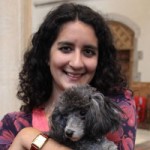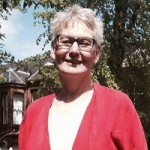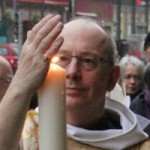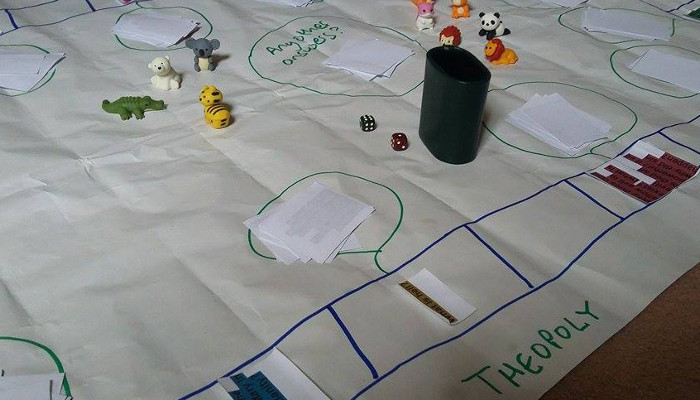Sophie Agrell: In the steps of St Ninian
The cathedral was dim, a far cry from its Sunday brightness, as we, warmly dressed and sensibly shod, put down our bags and rucksacks and gathered in a circle of friends and strangers around the altar. We prepared ourselves to journey towards the sea with St Brendan’s prayer in preparation for setting sail, the prayer of a man preparing to leave all he knew for a strange land as so many did in the early centuries of the church, and so many thousands do today.
“Shall I turn my back on my native land, and turn my face towards the sea? Towards the elements, the noise, the wind, the spray, the hostility, the misunderstanding, the abuse, the ridicule, the uncertainty, the fear, the isolation?”
Unlike early Christian explorers or modern refugees, our journey was not a final departure laden with fear and supported only by trust in God but a day pilgrimage to Whithorn, undertaken in modern comfort on a luxury coach by our group of 32 pilgrims, led by Rev Cedric Blakey and Rev Kirstin Freeman.
It is a surprisingly long way to Whithorn, particularly when a closure on the A77 sent us on a winding diversion through many extra miles of the beautiful countryside of the south west of Scotland. When we arrived at Whithorn, we were very thankful for the thoughtfulness of the kind people at the Whithorn Trust visitor centre, who had arranged tea and coffee in generous quantity in an upstairs room. Some of us – me among them – felt an imperative need for cake after the early start and long journey and were not disappointed. The baking in the visitor centre cafe is notably good!
Suitably refreshed, we were driven out beyond the town to our first real ‘destination’ – St Ninian’s cave. Like so many other figures in the early church and since, Ninian is said to have spent time in a cave on the beach, seeking quiet and space to pray and meditate away from the community in which he lived. Approached through a wooded glen, the bay gives a tremendous sense of peace even today with no houses visible, just the pebble beach with sea-rounded stones in a variety of colours.
The cave itself is small and narrow, marked by centuries of inscriptions from visiting pilgrims, some of whom have also left stones from the beach or small crosses as symbols of their prayer, intent or presence. The site has been a place of pilgrimage for over 1000 years, with the earliest carvings (now in the Whithorn museum) dating from the 700s or 800s.
We gathered in a circle outside the cave for a very simple short Eucharist, led by Rev Kirstin Freeman. A central element of the service was the idea of laying down the burdens of worry, anxiety for self or others, the need for forgiveness that we had carried on our pilgrimage. In turn, we each poured out a little water from a glass as a symbol of all that we were relinquishing and laying down in God’s care. It was very peaceful with the sole accompaniment to our prayers the rapid rhythm of the waves sweeping onto the rocks in front of the cave and the slightly softer sound as each wave ran up the pebble beach.
Thus spiritually refreshed, it was time for bodily sustenance and we scattered to find picnic spots and enjoy the surprisingly warm sunshine and the beauty of the sea. For many people, this quiet relaxed time on the beach was the highlight of the day – certainly it was for me.
All too soon it was time to return to the bus (pausing to pick brambles) and to Whithorn itself where the group again separated to make the most of the warm, sunny afternoon as seemed best to them, whether eating ice cream, taking a guided tour of the archaeology or heading for a pub to watch Scotland’s crucial game against Samoa (Scotland won!) in the Rugby Union World Cup.
I explored the ruined priory, built to house the relics of St Ninian. The Romanesque ruins we now see form part of what became a far larger structure, a combination of cathedral, priory and parish church, although it is hard to get a sense of the scale of the mediaeval structures, so completely have they vanished beneath the old graveyard, itself full of old stones telling complicated stories of families’ misfortunes, long lives or the kindness of friends.
Earlier stones, mostly dating from the tenth and eleventh century and unearthed in Whithorn and the surrounding area, form the core of the priory museum. While the ‘Latinus stone’, Scotland’s earliest Christian monument with a Latin inscription and a chi-rho symbol is probably considered the ‘star exhibit’, I particularly enjoyed some of the stones with ‘Celtic’ interlace patterns – not least because the carvers made mistakes! Seeing the points where a curve had been carved in the wrong direction or a mistake made in the rhythm of the pattern made the long-dead carvers human and living for me in a way perfection could not.
After tea, more delicious cake and a brief service in the priory ruins, it was time to head north back to Glasgow where eventually tired pilgrims arrived, enriched by history and the beauty of Whithorn and St Ninian’s bay.
Sermon preached on 11 October 2015 by Cedric Blakey
Gifts and Skills – Week 2
Session 2 Me and God
In the second session we will consider further our relationship with God – how do we hear God, what gets in the way of that process? How can we be more present to God? In this process of ‘discerning our gifts and skills’, how will we understand God’s role in our lives and in our flourishing as talented humans?
Gifts and Skills Week 1
In this first session we will get to know one another and think about what has brought us to this course: while this is a personal journey, for these weeks we will accompany one another in our path of discernment. This is an opportunity to take stock. Where are we in our lives? What engages us, what challenges do we face, what experience do we bring? Over the coming weeks we will be developing our practice of reflection and we will start that process at our first meeting.
Anne Jones: Visit to our nearest mosque
Last Friday night, like many Glaswegians throughout the city, I had a curry for dinner. However, I dId not head for the local take away or restaurant, instead I made my way to the Al’Furquan Mosque in the West End of Glasgow, as a guest of the Muslim community there, invited to join them in their celebrations of Eid. It is their custom to ask their neighbours to a meal on these occasions and their guests included members of the local churches as well as students and other folk who live nearby. St Mary’s Cathedral is their nearest church, which is why I was fortunate to be there.
I had never been to such an event before, in fact I had never been to a mosque before, and although I knew the Provost and another member of our congregation would be there, it was with a little apprehension of the unknown that I arrived at the hall next to the mosque for the meal. Within minutes of my arrival I was completely reassured. Three young Muslim women greeted me with smiles, jokes at each other’s expense, and admiration of the interior of St Mary’s, which they had visited out of curiosity. I was whisked into the hall by two of the women and seated at a table near the door. I was early and the room was almost empty. We chatted, how we chatted, about our families, our backgrounds, my role at the Cathedral and their role at an Islamic Centre in a nearby town. Before I knew it the tables had filled up and the proceedings started.
We were formally welcomed by members of the Mosque, including their President. They spoke movingly of their desire for dialogue within their local community and beyond, to ensure all diverse groups could meet together in friendship, acceptance and above all peace. They drew attention to the standing banners, which were arranged round two sides of the hall. One set was entitled The Celtic Crescent, the result of research by members of the mosque to describe the link between Islam and the Celtic history and culture. The other set described the Five Pillars of Islam, faith, prayer, fasting, charity and pilgrimage, which are the five basic acts in Islam and the mainstay of Muslim life. We were told that the Mosque is open five times a day for the prayer, as prescribed by their faith, and were invited to call in at any time.
The buffet meal that followed was delicious and the hospitality most generous. There were twelve tables with ten people at each table and yet very quickly everyone had helped themselves to the fragrant, appetising dishes. Mmmm, the seekh kabab, chicken tikka, baby potatoes, vegetable spring rolls! Yum, vegetable curry, lamb karahi , pilau rice and naan bread! What a feast, what a celebration! And all round the hall the conversation and laughter continued.
While we ate the dessert we heard a young Muslim academic deliver a talk entitled In the Footsteps of Abraham. He told us that the Eid we were celebrating had links with the Hajj (pilgrimage) to the Grand Mosque at Mecca and spoke sadly of the deaths caused this year when a huge crane collapsed on a crowded square and later when an even greater loss of life occurred when pilgrims were crushed to death in the heaving crowds. He described the importance of the sacred history and worship of the prophet Abraham and in quiet, lilting tones sang from the Koran, telling the story of Abraham and his son, Isaac.
It was then time for thanks from the guests. Members of the Church of Scotland, the Reformed Church, Interfaith Scotland and our provost, representing St Mary’s Cathedral, spoke of their appreciation of the opportunity to meet in this way. Kelvin described how part of our Eucharist includes the Peace when the congregation wish each other peace with a handshake. At this point he shook the hand of the President of the Muslim community and said the words, “Peace be with you”.
We knew from the original invitation that the event was due to finish at nine o’clock but when it got near to this time we were told that if anyone would like to go to see what happens at the final prayers of the day in the Mosque then we would be welcome to go along. At this point one of the young women who had welcomed us invited some of us to join her in the women’s upstairs room while she said her prayers before returning home. She explained that she had not attended the earlier prayers and now needed to catch up. She would say the final prayers of the day later at home. We followed her upstairs to a long, bare, softly lit room, the floor covered in a spotless red and gold carpet with individual prayer mats incorporated in the design. We stood in silence while she said her prayers, kneeling and touching the floor with her forehead repeatedly. She prepared then to go home while we went downstairs to the main Mosque. But as she left she turned back, rushed up to me and two young women guests, kissed us in turn and was gone. It was a moving moment.
Downstairs in the main mosque, chairs had been placed at the back for the visitors while at the front the men’s final prayers of the day had begun. The prayers were chanted and the men went through the ritual of standing, kneeling and prostrating themselves. Throughout this time men continued to arrive and afterwards it was explained that latecomers stay behind to complete the whole pattern of prayer.
The evening over the guests drifted out into the Autumn evening. It was a fascinating evening, over too soon, and opened my eyes to a religion and culture I knew only the basics about. It was privilege to have been there.
And I will never forget that young woman rushing back to kiss me.
Sermon preached on 4 October 2015 by Kelvin Holdsworth
Sermon preached on 27 September 2015 by Cedric Blakey
Cedric Blakey: Theopoly – the God Game
The Vice Provost, Cedric Blakey has devised a game to enable small groups talk about God. In this week’s article explains why he did it and how it works.
I have found an astonishing interest and energy for enquiry about God in Glasgow. The following were just a few of the questions asked by the God Factor course group earlier this year:
- Does God exist? Who created God?
- What does God look like/ feel like?
- Why does God allow and permit evil to exist?
- Is God a man?
- Does God ever change?
How can we initiate exploration of these kinds of questions, and enable discussion about God?
I have devised a game called Theopoly. Depending on the size of the group it can be played competitively with dice, or collaboratively standing round a table. The aim is to achieve, not riches and capitalist property owning domination, but ideas, arguments from a community chest of possibilities.
There is a ‘board’ with squares round the four sides, as in a Monopoly board, and a set of animal characters for participants to identify themselves. On some of the squares are placed the questions asked by the group. Players choose a symbol and in the collaborative version of the game, then walk round the table placing their symbol on the square that most interests them.
By each question there is a set of possible answers, placed upside down on separate squares of paper. Each participant then takes turn to read out their chosen question and to turn over the possible answers, reading them out and retaining the ones that they find helpful, returning the ones that they don’t. Other participants can ‘steal’ any unwanted answer. Participants can add their own answers, writing them on blank squares of paper and adding them to the answer piles.
In a short period of time a great deal of ground can be covered. For instance, the person choosing the question “Does God exist?” last time found five possible answers. The first was “The Bible says so.” Not very helpful, they said. The second answer was “The existence of God is a fantasy, deluded people’s ‘invisible friend’”. There is an interest in contemporary secularism, but so far this response has not been chosen either.
The remaining answers came from other so-called “proofs” of the existence of God: the existence of beauty and love, science, philosophy and personal experience. So we have “Where else could the experience of beauty and human love have come from?” “Scientists who had a belief in God include Newton, Kepler, Kelvin, and Einstein.” “Plato, Aristotle, Immanuel Kant argued the existence of God from the existence of good.” “God has changed my life- some people say.”
In turning over the provided answers participants naturally begin to speak of counter arguments and other arguments in favour. They find a space, standing together around the table to throw in ideas, tell stories and make reference to books, films and personal experience. It is a fast-moving process, once the conversation on a particular subject flags another person takes their turn.
What emerges is a process that enables individuals and the group to speak about God. This appears to be something that folk want to do these days.
Taking seriously questions about God form an important part of our understanding about what people are asking about. In turn this has informed the provisions of other parts of the adult learning experience at St Mary’s, not least the Sunday preaching, the shaping of the liturgy and music, the explaining of the building and its use, and the motto of the congregation “Open, Welcoming, Inclusive”.
It’s wonderful irony of course. For it is impossible to speak about God adequately. And on occasions it is just not possible, or appropriate, at all. And if one tries, it is with great delicacy. What does one say after the Clutha bar helicopter crash? Or the pre-Christmas Queen Street bin lorry tragedy. Or the post-referendum crowd clashes in George Square. What do we say by the bedside of the critically ill and alongside the broken in spirit? And what do we think of within ourselves when faith feels inadequate or is absent. When someone lets us down. Or equally, when we know we have failed against our own standards of being and practice.
This process is not an optional extra to the life of the church, or to any Christian. Speaking about God is one of life’s essentials. In the busy office, the sports centre, bus stop and on-line. How we equip ourselves and others to do it, and to do it authentically is just one reason to try Theopoly.
The game of Theopoly is often played during the God Factor course.






